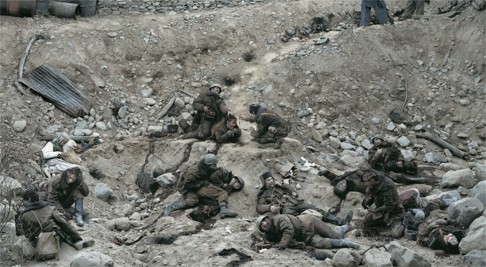
Moving stills: Jeff Wall on the art of his photography, currently on show in Hong Kong
The Canadian artist calls his work ‘cinematography’ even though he only ever creates still images of subjects and stories that he is reluctant to interpret

Sometimes, it pays to be anachronistic.
In 2012, a work by Jeff Wall was sold for US$3.6 million, making it the third most expensive photo ever sold at auction. Few people work like the 69-year-old Canadian artist any more. He still uses film, though not exclusively; still shoots with a large-format camera, and has never been tempted to make moving images at a time when every smartphone doubles as a movie camera. A man who describes his own work as cinematographic has stuck with stills.
“I call my works cinematography because I’ve always admired how cinematographers do their photography. I thought that’s how I’d like to work. Not because I want to make films,” he says at the launch of his first solo exhibition in Asia.
“I love pictures. I always have. I like their stillness, which is so open and free. I like the fact that they don’t have to complete a story.”
Dead Troops Talk (A Vision After an Ambush of a Red Army Patrol, Near Moqor, Afghanistan, Winter 1986), the photograph that was auctioned in 2012, is one of his incomplete stories.

“My picture Dead Troops Talk has a literary origin in a way, like I’d written it,” Wall says.
This 1992 work of his has been much analysed and written about. Susan Sontag had called it one of the most thoughtful, coherent and passionate “antiwar images”. But Wall has always been reluctant to interpret it.
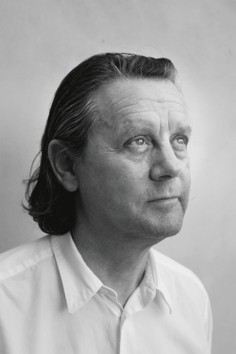
He also rejects any notion of a fixed modus operandi. He stages imaginary scenes as much as he recreates scenes he’s seen and filed away, or he just photographs real-life situations as they happen.
Among the trio of landscapes shown in White Cube’s downstairs space is Daybreak (Harvest Workers on an Olive Farm in the Negev, Israel). Wall says this work is completely “factual”.
He’d seen a group of Bedouin who were sleeping right by the olive farm where they worked as seasonal harvesters, in stark contrast to the lives of the inmates of a prison that can be seen a few metres away. It was a powerful image that just presented itself.
“It was one of those really remarkable circumstances that made it into a really complicated, but beautiful, landscape,” he says.
He didn’t photograph it at the time, but went back a year later and asked the harvesters to allow their picture to be taken.
By contrast, Listener, one of the portraits upstairs, was produced in the same vein as Dead Troops Talk.
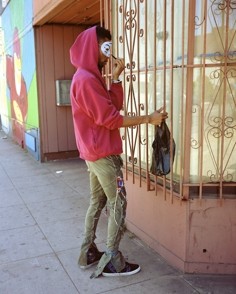
Wall refuses to give this compelling image much of a backstory. It was inspired by news photos depicting groups who had a person under their control, he says.
“The group would bring that person out to a place for some possibly not very good reason, and that person almost always ends up on the ground. I felt that I wanted to reconstruct that, not to talk about this conflict or that conflict, but to study the interrelationship between the group itself and … this other person, who may have been part of that group recently,” he says.
In the real world, by the time the person is taken to this situation, there is nothing to talk about. In the scene, the man on the ground is talking and even more unbelievably, one of the group is bending down to listen.
“I don’t want to say more than that because it’d move into interpretation and I don’t think I should be an interpreter,” he says.
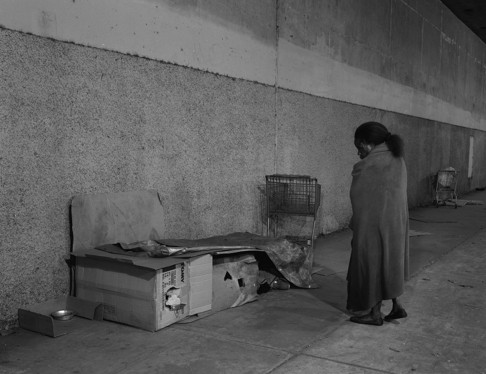
Wall’s firm rejection of a specific authorial intent extends to his telling of how the image came to be. The shoot had worked like improv theatre, he explains. The model acting the part of the outcast had picked that role himself and then he took his shirt off, possibly because it was hot. It was a complete accident that he now comes across as Christ-like and looks vulnerable in his state of semi-undress, Wall says.
“People have mentioned that it might be a scene from the road to Calvary. I knew when this particular guy took this part, that he resembled these clichés of Jesus and I let it be,” Wall says.
A photographer can never predict how the final image appears and that’s how photography as art gets interesting, he adds.
Mask Maker and Approach show something that he’d witnessed on the street and later recreated with actors. The former shows a man drawing on a mask he’s wearing and checking his reflection in a shuttered shop’s window. In Approach, a woman wrapped in a blanket is looking at a cardboard shelter, from which a shoe protrudes.
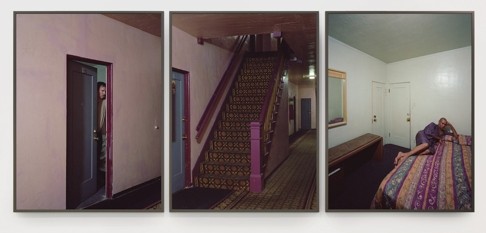
There is a quirkiness in the images that set them apart from news photography. Wall isn’t out to make social commentaries about poverty, homelessness or loneliness. He says he just follows what catches his eye and quite often, it is a situation where someone is coping with difficulties. “We are all fascinated by difficulty because we all have them,” he says.
That fascination is what took him to a boarding house in Hollywood, where he shot a triptych titled Staircase & Two Rooms. These images dominate the upper section of White Cube’s split level space.
Like all the prints on show, they are life-size images that suck the viewers in, so much so that they can feel the texture of the generic bedcover and the threadbare carpet in the common area. The right hand panel shows a man sitting on his bed in a dressing gown. On the left, a man peers out from his lonely cell. These were not models, but actual residents of the boarding house.
There is no pity, no envy, no particular emotion or empathy. Wall’s view of the world is made up by these quiet, random fragments that most of us walk by without a glance.
Jeff Wall, White Cube, 50 Connaught Road Central, Tue-Sat, 11am-7pm. Ends January 23